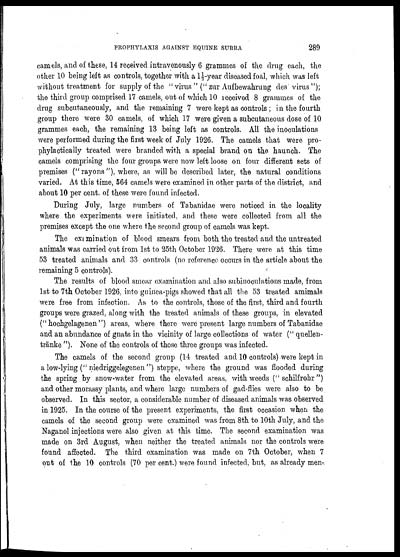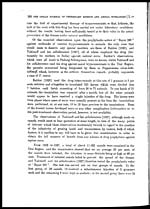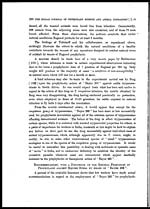Medicine - Veterinary > Veterinary colleges and laboratories > Indian journal of veterinary science and animal husbandry > Volume 1, 1931 > Part IV (December 1931) > Prophylaxis against equine surra by means of "Bayer 205" (Naganol) (A review of the literature)
(336) Page 289
Download files
Individual page:
Thumbnail gallery: Grid view | List view

PROPHYLAXIS AGAINST EQUINE SURRA 289
camels, and of these, 14 received intravenously 6 grammes of the drug each, the
other 10 being left as controls, together with a 1½ year diseased foal, which was left
without treatment for supply of the " virus" ("zur Aufbewahrung des virus");
the third group comprised 17 camels, out of which 10 received 8 grammes of the
drug subcutaneously, and the remaining 7 were kept as controls ; in the fourth
group there were 30 camels, of which 17 were given a subcutaneous dose of 10
grammes each, the remaining 13 being left as controls. All the inoculations
were performed during the first week of July 1926. The camels that were pro-
phylactically treated were branded with a special brand on the haunch. The
camels comprising the four groups were now left loose on four different sets of
premises ("rayons"), where, as will be described later, the natural conditions
varied. At this time, 564 camels were examined in other parts of the district, and
about 10 per cent. of these were found infected.
During July, large numbers of Tabanidae were noticed in the locality
where the experiments were initiated, and these were collected from all the
premises except the one where the second group of camels was kept.
The examination of blood smears from both the treated and. the untreated
animals was carried out from 1st to 25th October 1926. There were at this time
53 treated animals and 33 controls (no reference occurs in the article about the
remaining 5 controls).
The results of blood smear examination and also subinoculations made, from
1st to 7th October 1926, into guinea-pigs showed that all the 53 treated amimals
were free from infection. As to the controls, those of the first, third and fourth
groups were grazed, along with the treated animals of these groups, in elevated
("hochgelagenen") areas, where there were present large numbers of Tabanidae
and an abundance of gnats in the vicinity of large collections of water (" quellen-
tränke "). None of the controls of those three groups was infected.
The camels of the second group (14 treated and 10 controls) were kept in
a low-lying (" niedriggelegenen") steppe, where the ground was flooded during
the spring by snow-water from the elevated areas, with weeds (" schilfrohr")
and other morassy plants, and where large numbers of gad-flies were also to be
observed. In this sector, a considerable number of diseased animals was observed
in 1925. In the course of the present experiments, the first occasion when the
camels of the second group were examined was from 8th to 10th July, and the
Naganol injections were also given at this time. The second examination was
made on 3rd August, when neither the treated animals nor the controls were
found affected. The third examination was made on 7th October, when 7
out of the 10 controls (70 per cent.) were found infected, but, as already men-
Set display mode to: Large image | Zoom image | Transcription
Images and transcriptions on this page, including medium image downloads, may be used under the Creative Commons Attribution 4.0 International Licence unless otherwise stated. ![]()
| Permanent URL | https://digital.nls.uk/75226803 |
|---|
| Description | Covers articles from 1931. |
|---|




